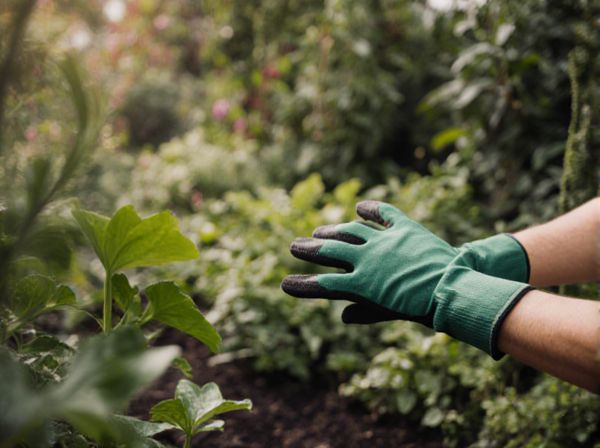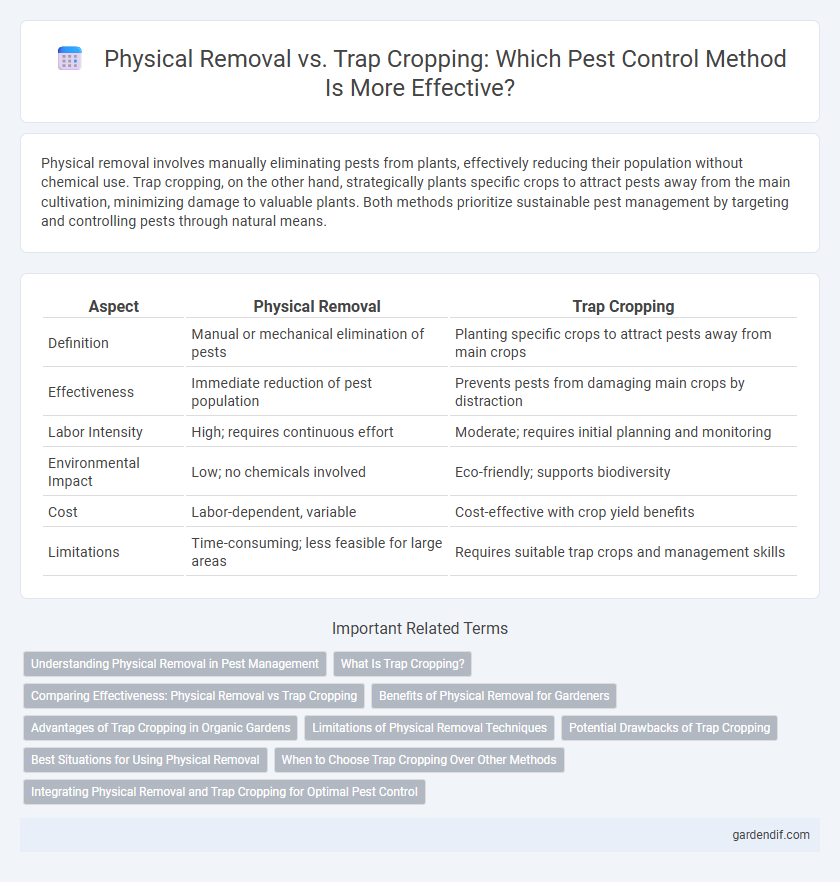
Physical removal vs Trap cropping Illustration
Physical removal involves manually eliminating pests from plants, effectively reducing their population without chemical use. Trap cropping, on the other hand, strategically plants specific crops to attract pests away from the main cultivation, minimizing damage to valuable plants. Both methods prioritize sustainable pest management by targeting and controlling pests through natural means.
Table of Comparison
| Aspect | Physical Removal | Trap Cropping |
|---|---|---|
| Definition | Manual or mechanical elimination of pests | Planting specific crops to attract pests away from main crops |
| Effectiveness | Immediate reduction of pest population | Prevents pests from damaging main crops by distraction |
| Labor Intensity | High; requires continuous effort | Moderate; requires initial planning and monitoring |
| Environmental Impact | Low; no chemicals involved | Eco-friendly; supports biodiversity |
| Cost | Labor-dependent, variable | Cost-effective with crop yield benefits |
| Limitations | Time-consuming; less feasible for large areas | Requires suitable trap crops and management skills |
Understanding Physical Removal in Pest Management
Physical removal in pest management involves manually extracting pests from plants, which reduces pest populations without chemicals. This method is effective for small infestations and can prevent damage by directly targeting pests like aphids, caterpillars, and beetles. Trap cropping, in contrast, uses sacrificial plants to attract pests away from main crops, but physical removal provides immediate control by eliminating pests on contact.
What Is Trap Cropping?
Trap cropping is an agricultural pest management strategy where specific plants are cultivated to attract pests away from the main crop, effectively reducing damage. Unlike physical removal, which involves manually eliminating pests, trap cropping leverages plant preferences to concentrate pests in a designated area, facilitating easier control. This method minimizes pesticide use and promotes sustainable pest control by exploiting pest behavior and ecological interactions.
Comparing Effectiveness: Physical Removal vs Trap Cropping
Physical removal effectively reduces pest populations by directly eliminating insects from crops, offering immediate results with labor-intensive application. Trap cropping attracts pests away from main crops, minimizing damage but requiring strategic planning and monitoring for optimal effectiveness. Comparative studies indicate physical removal yields faster pest suppression, while trap cropping supports sustainable pest management by lowering pesticide reliance.
Benefits of Physical Removal for Gardeners
Physical removal offers gardeners an immediate and chemical-free method to control pests by manually eliminating harmful insects and larvae from plants. This technique reduces pest populations without disrupting beneficial insects or causing environmental harm, making it ideal for organic gardening practices. Regular physical removal helps prevent infestations from spreading, promoting healthier plant growth and higher crop yields.
Advantages of Trap Cropping in Organic Gardens
Trap cropping in organic gardens effectively reduces pest populations by attracting pests away from main crops, minimizing the need for physical removal methods. This strategy enhances biodiversity, supports beneficial insect populations, and reduces reliance on chemical interventions. Implementing trap crops increases overall plant health and yields by creating a targeted pest management system.
Limitations of Physical Removal Techniques
Physical removal techniques for pest control, such as handpicking and vacuuming, are labor-intensive and often impractical for large-scale agricultural operations. These methods are limited by the pests' rapid reproduction rates and ability to hide in crop foliage or soil, reducing effectiveness. Unlike trap cropping, physical removal lacks the spatial strategy needed to divert pests away from main crops, leading to inconsistent pest suppression.
Potential Drawbacks of Trap Cropping
Trap cropping can attract pests away from the main crop but may inadvertently harbor pests if not properly managed, leading to increased pest pressure over time. Physical removal requires significant labor and may not be effective against highly mobile or widespread pest populations. Relying solely on trap cropping risks pest populations migrating back to the primary crop, reducing overall pest control efficiency.
Best Situations for Using Physical Removal
Physical removal is most effective for managing small pest populations in contained garden spaces or greenhouses where manual intervention is feasible. It offers immediate reduction of pest numbers without chemical use, making it ideal for delicate crops sensitive to pesticides. This method works best when pests are visible and concentrated, enabling precise targeting and minimizing damage.
When to Choose Trap Cropping Over Other Methods
Trap cropping is ideal when targeting specific pest species that prefer certain plants, allowing for localized pest control without widespread chemical use. It is especially effective in large-scale agricultural settings where physical removal is labor-intensive and impractical. Choosing trap cropping can enhance integrated pest management by reducing pest populations before they reach the main crop, minimizing crop damage.
Integrating Physical Removal and Trap Cropping for Optimal Pest Control
Integrating physical removal with trap cropping enhances pest control efficiency by targeting pests through multiple mechanisms, reducing pest populations before they reach economic damage levels. Physical removal directly eliminates pests from crops, while trap crops act as pest attractants, concentrating pests away from main crops for easier removal or containment. This combined approach reduces reliance on chemical pesticides, promotes sustainable agriculture, and supports effective, environmentally friendly pest management strategies.
Physical removal vs Trap cropping Infographic

 gardendif.com
gardendif.com